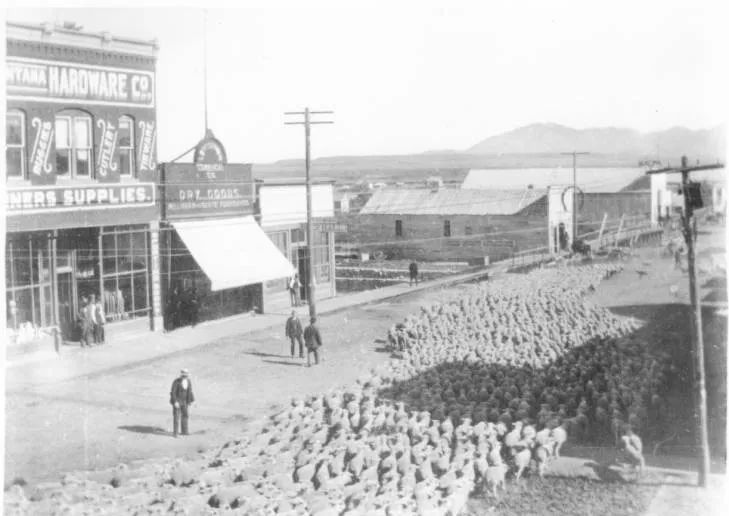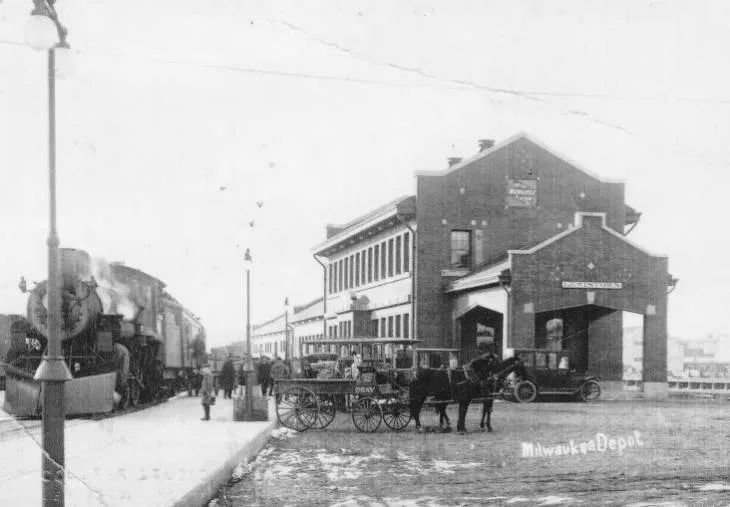
A Tour of Historic Lewistown
This tour will cover:
- Central Business Historic District
- Courthouse Square District
- Silk Stocking District
- Judith Place District
- Stone Buildings District
- Satellite Airfield
- Railroads
A Brief History of Lewistown
Initially Lewistown existed as a trading post for a nomadic way of life, serving mostly Native Americans, traders, hunters and trappers. In 1874 Company F of the 7th Infantry selected a site near Story’s Fort for Camp Lewis. The temporary military post was established to protect commerce on the Carroll Trail and was named in honor of Major W.H. Lewis. It is likely the name “Lewistown,” selected 10 years later, was derived from the military post.

Some 25 Metis families, descendants of the French and Indians, established the first permanent settlement in 1879. On January 6, 1881, Reed’s Post Office was established to serve “Big Spring Creek” and its 150 Metis families. The original log post office still stands and is located at the junction of Brassey Street and Casino Creek Drive. The present site of Lewistown was taken as homesteads by two of those settlers, Francis Janeaux and Paul Morase. Lewistown streets bear the French names of some of these first settlers.
N.M. Erickson petitioned in 1883 for a post office designation for Lewistown and the abandonment of Reed’s Fort. Erickson was successful, and he was named Lewistown’s first postmaster on March 10, 1884. His efforts to “boom” the town and the political connections to T.C. Power paid off with Lewistown being designated the county seat when Fergus County was created in 1885.
Cattlemen began to take advantage of the open range in Central Montana. The discovery of gold in the Judith and Moccasin Mountains spurred the growth of several mining camps. These developments encouraged Janeaux to build a store and plat part of his land for a village. Dr. L.A. Lapalme, Lewistown’s first M.D., laid out the townsite in 1882 using a fence for a starting line, which probably explains having streets in a southwest-northeast orientation.
The sheep industry, which began around 1882, was a major contributor to the permanent prosperity and the steady development of the area, and many sheep ranchers entered banking, land, and commercial ventures in Lewistown. George Cook, David Hilger, Bernard Stack, James Fergus, S.S. Hobson, J.D. Waite, F.R. Warren, J.S. Huntoon, R.B. Thompson, Samuel Phillips, John Brooks, A.C. Green, and G.M. Stone were among the pioneer sheepmen whose names are linked to many businesses and structures within the historic districts. Lewistown was becoming the business and trading center for a growing stock, farming, and mining region. In May of 1899, Lewistown was incorporated as a city. By the turn of the century the population of the city was 1096, but the land rush was on and Lewistown experienced tremendous growth as a result.

The Montana (or “Jawbone”) Railroad gave Lewistown its first train service in 1903. It was purchased and improved in 1908 by the Chicago, Milwaukee, and St. Paul Railroad. The “Milwaukee Road” provided convenient access to the developing prairie with regularly scheduled train service. The improved service lowered shipping costs; many structures built after the “Milwaukee Road” arrived exhibited increased use of “imported” building materials such as terra cotta, art glass, and finely milled lumber.

The Great Northern Railroad extended a branch line to Lewistown in 1913, and both railroads encouraged homesteading and expansion of wheat farming. The homestead phenomenon had a significant impact on the growth of the community. In a short period of time the town emerged as a growth area, matured into an established city, and stabilized as a centralized exchange for area resources and needs.

Architects and engineers continued the widespread use of stone in their earliest buildings when they came to town, resulting in beautiful blends of old world craftsmanship combined with the popular and exuberant eclecticism of America’s architecture of the period.
The architectural firm of Wasmansdorff & Eastman designed the stone masonry Masonic Temple, and the brick IOOF/KP and Bank Electric buildings. The firm of Link & Haire may be best remembered for their use of terra cotta on the Montana Building, the Judith Theatre, and the Warr-Lane Building. The designers of the State Capital, J.H. Kent and C.E. Bell, collaborated on the Bank of Fergus County and individually on several structures. Kent is linked with the stone Diamond Block that illustrates a blend of stone craftsmanship and professional design.
A favorable climate and good agriculture commodities prices spurred the community’s growth until 1919, when the worst drought in Montana’s history began. For several years falling prices, drought, and insect infestation drove homesteaders from their land and the Great Depression, which crippled Montana’s economy long before the Stock Market Crash of 1929, effectively put an end to the expansion and development of downtown Lewistown.
Lewistown has never experienced growth to compare with its formative years; however the city was established as the area’s major trading center and has continued in a similar role to the present. Ironically, the years of hard times that followed the boom years can be thanked for a prt in the preservation of the marvelous old structures we still enjoy; continued use made economic sense. It is a lesson we should remember so future generations may continue to take pride in our founders’ courage and optimism.
Since 1985 six historic districts in Lewistown have been listed on the National Register of Historic Places, recognizing the local, regional, and national significance of the development that has occurred in Lewistown from the late 19th century through the middle of the 20th century. Residences and businesses, churches and military installations are reflected in the preservation of our history in Central Montana.
Enjoy your tour of Lewistown’s historic districts and structures!
Up Next
The information contained here comes from A Tour of Historic Lewistown, a brochure prepared by the Lewistown Historic Resources Commission. Material for this brochure was collected from architectural and historical inventories and National Register nominations forms. Photographs came from the City of Lewistown, the Lewistown Public Library, and the Montana Memory Project.
For information on these and other historic resources in Lewistown, contact the Historic Preservation Office located in the City Planning office, or call 406-535-1775.






